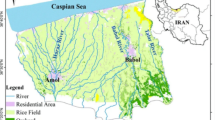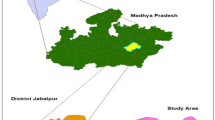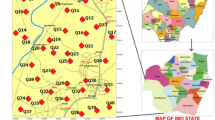Abstract
The artificial neural networks share its working analogous with the human brain; and by using these artificial neural models, various complex nonlinear relationships can be modeled which cannot be described easily using mathematical equations. In this study, groundwater quality at a sanitary landfill site used for solid waste disposal was modeled using artificial neural networks. The groundwater quality was assessed for two consecutive years 2016 and 2017 at ten locations near the site, and the data were used for modeling. Total hardness was predicted using neural networks by using three learning algorithms, and the best one was used in the final model for prediction. The interpolation maps were drawn for both the years to understand the total hardness concentrations at unsampled locations using ArcGIS Geostatistical Analyst Extension, and Inverse Distance Weighing method was used. The percentage effect of spatial and temporal changes on total hardness was calculated by doing the sensitivity analysis and thus finding the relative importance of each input parameter on total hardness. Different algorithms were tested to select the best-performing algorithm with optimal neural architecture.












Similar content being viewed by others
References
Basheer, I. A., & Hajmeer, M. (2000). Artificial neural networks: Fundamentals, computing, design, and application. Journal of Microbiological Methods,43(1), 3–31.
Bashir, M. J. K., Isa, M. H., Kutty, S. R. M., Awang, Z. B., Aziz, H. A., Mohajeri, S., & Farooqi, I. H. (2009). Landfill leachate treatment by electrochemical oxidation. Waste Management, 29(9), 2534–2541.
Charulatha, G., Srinivasalu, S., Maheswari, O. U., Venugopal, T., & Giridharan, L. (2017). Evaluation of ground water quality contaminants using linear regression and artificial neural network models. Arabian Journal of Geosciences,10, 128.
Christensen, T. H., Kjeldsen, P., Bjerg, P. L., Jensen, D. L., Christensen, J. B., et al. (2001). Biogeochemistry of landfill leachate plumes. Applied Geochemistry,16, 659–718.
Daliakopoulosa, I. N., Coulibalya, P., & Tsanisb, I. K. (2005). Groundwater level forecasting using artificial neural networks. Journal of Hydrology,309, 229–240.
Dogan, E., Sengorur, B., & Koklu, R. (2009). Modeling biological oxygen demand of the Melen River in Turkey using an artificial neural network. Journal of Environmental Management,90, 1229–1235.
El-Salam, M. M. A., & Abu-Zuid, I. G. (2015). Impact of landfill leachate on the groundwater quality: A case study in Egypt. Journal of Advanced Research,6, 579–586. https://doi.org/10.1016/j.jare.2014.02.003.
Fatta, D., Papadopoulos, A., & Loizidou, M. (1999). A study on the landfill leachate and its impact on the groundwater quality of the greater area. Environmental Geochemistry and Health,21, 175. https://doi.org/10.1023/A:1006613530137.
Garson, G. D. (1991). Interpreting neural-network connection weights. AI Expert,6(7), 47–51.
http://www.newgeography.com/content/002808-world-urban-areas-population-and-density-a-2012-update. Accessed 10 Jan 2018.
Kuo, Y. M., Liu, C. W., & Lin, K. H. (2004). Evaluation of the ability of an artificial neural network model to assess the variation of groundwater quality in an area of blackfoot disease in Taiwan. Water Research,38, 148–158.
Lee, G. F. & Lee, A. J. (1993). Groundwater quality protection: A suggested approach for water utilities. Report to the CA/NV AWWA section source water quality committee, p. 8.
Maier, H. R., & Dandy, G. C. (1996). The use of artificial neural networks for the prediction of water quality parameters. Water Resources Research,32(4), 1013–1022.
Mattei, F., Franceschini, S., & Scardi, M. (2018). A depth-resolved artificial neural network model of marine phytoplankton primary production. Ecological Modelling,382, 51–62.
Mohanty, S., Jha, M. K., Kumar, A., & Sudheer, K. P. (2010). Artificial neural network modeling for groundwater level forecasting in a river island of eastern India. Water Resource Management,24, 1845–1865.
Moo-Young, H., Johnson, B., Johnson, A., Carson, D., Lew, C., & Liu, S. H. (2004). Review characterization of infiltration rates from landfills: Supporting groundwater modeling efforts. Environmental Monitoring and Assessment,96(1–3), 283–311.
Mor, S., Khaiwal, R., Dahiya, R. P., & Chandra, A. (2006). Leachate characterization and assessment of groundwater pollution near municipal solid waste landfill site. Environmental Monitoring and Assessment,118, 435–456.
Moreira, T. M., & Fiesler, E. (1995). IDIAP technical report neural networks with adaptive learning rate and momentum. Institutdalle molled’intelligence artificielle perceptive case postale609 - 1920 MARTIGNY - VALAIS - SUISSE.
Murphy, R. R., Curriero, F. C., & Ball, W. P. (2010). Comparison of spatial interpolation methods for water quality evaluation in the Chesapeake Bay. Journal of Environmental Engineering,136, 160–171. https://doi.org/10.1061/_ASCE_EE.1943-7870.0000121.
Nagarajan, R., Thirumalaisamy, S., & Lakshumanan, E. (2012). Impact of leachate on groundwater pollution due to non-engineered municipal solid waste landfill sites of Erode city, Tamil Nadu, India. Iranian Journal of Environmental Health Science & Engineering,9(1), 35. https://doi.org/10.1186/1735-2746-9-35.
Nas, B., & Berktay, A. (2010). Groundwater quality mapping in urbangroundwater using GIS. Environmental Monitoring and Assessment,160, 215–227.
Nayak, P. C., Rao, Y. R. S., & Sudheer, K. P. (2006). Groundwater level forecasting in a shallow aquifer using artificial neural network approach. Water Resources Management,20, 77–90.
Palani, S., Liong, S. Y., & Tkalich, P. (2008). An ANN application for water quality forecasting. Marine Pollution Bulletin,56, 1586–1597.
Sawyer, C. N., McCarty, P. L., & Parkin, G. F. (1994). Chemistry for environmental engineering. Singapore: McGraw-Hill Inc.
Singh, K. P., Basant, K., Malik, A., & Jain, G. (2009). Artificial neural network modeling of the river water quality—A case study. Ecological Modelling,220, 888–895.
Singh, U. K., Kumar, M., Chauhan, R., Jha, P. K., Ramanathan, A. L., & Subramanian, V. (2008). Assessment of the impact of landfill on groundwater quality: A case study of the Pirana site in western India. Environmental Monitoring and Assessment,141, 309. https://doi.org/10.1007/s10661-007-9897-6.
Smith, M. (1994). Neural networks for statistical modelling (p. 235). New York: Van Nostrand Reinhold.
Yesilnacar, M. I., Sahinkaya, E., Naz, M., & Ozkaya, B. (2008). Neural network prediction of nitrate in groundwater of Harran Plain, Turkey. Environmental Geology,56(1), 19–25.
Author information
Authors and Affiliations
Corresponding author
Additional information
Publisher's Note
Springer Nature remains neutral with regard to jurisdictional claims in published maps and institutional affiliations.
Rights and permissions
About this article
Cite this article
Sunayana, Kalawapudi, K., Dube, O. et al. Use of neural networks and spatial interpolation to predict groundwater quality. Environ Dev Sustain 22, 2801–2816 (2020). https://doi.org/10.1007/s10668-019-00319-2
Received:
Accepted:
Published:
Issue Date:
DOI: https://doi.org/10.1007/s10668-019-00319-2




